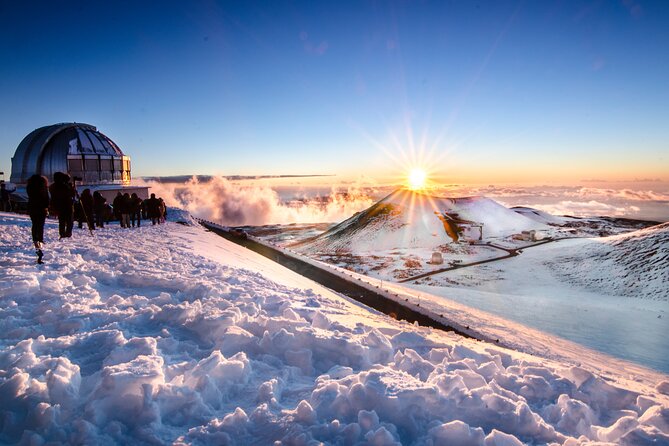Experience big skies and incredible nighttime views on this Mauna Kea stargazing trip
This bucket-list experience whisks you up to the Mauna Kea summit Watch the sunset from the mountaintop, and see the stars come out on this small-group trips to Mauna Kea—the highest point in the Hawaiian islands. —you can change into a warm jacket and pair of gloves, and sip a hot beverage, as the sun starts to set. Then, learn why so many research telescopes are located here during a brilliant celestial show.
- Spectacular solar and astronomical sightings through high-powered telescopes
- Guide
- Hooded parkas and gloves
- Transportation in a comfortable 4X4 van
- Snacks and a hot beverage
- Jackets and gloves to keep you warm
Rainbow Falls Start your adventure in quaint Hilo town where you’ll drive along the historic waterfront before arriving at Rainbow Falls. This iconic waterfall right off a postcard features an 80 foot tall twin waterfall system. Look for the rainbow effect that gives the waterfall its name!
Boiling Pots
Saddle Road
Next, you’ll travel across Saddle Road between Mauna Kea and Mauna Loa, two of the tallest and most massive volcanoes on Earth. Your National Park Service trained guide will discuss the volcanology, geology, and history of these monstrous wonders, as well as providing in-depth narration on the various lava flows and flora and fauna that you’ll be passing by. While you’re taking in the breathtaking terrestrial views, your guide will prepare some heavenly views just as stunning. Setting up a state of the art solar telescope for your viewing pleasure, your specially trained guide will let you safely watch the sun come alive in true color with vibrant solar flares, sunspots, prominences and any other current activity weather permitting.
Mauna Kea
Your guide will take you to one of our preferred locations on Mauna Kea for nighttime stargazing. You’ll observe deep sky and planetary objects through a large aperture Dobsonian telescope under one of the darkest and most pristine skies on planet Earth! Our Dobsonian telescopes are a true purist’s experience to view the night sky. Their fast focal ratio enables you to see sprawling wide field views of objects that simply aren’t possible with the types of telescopes used by other tours. Depending on what is visible in the current sky and weather permitting, you’ll observe galaxies, nebula, star clusters, planets, double star systems, the moon, and much more; all the highlights and showpiece objects like you’ve never seen before!
Maunakea Visitor Information Station Maunakea is a celebrated and storied place in the cultural traditions of Hawai’i. While it is the dwelling place of the goddess Poli’ahu it is also associated with the Hawaiian deities Lilinoe and Waiau. The summit was considered the realm of the gods and in ancient times was kapu (forbidden) to all but the highest chiefs and priests. Occasionally Hawaiian ali’i (royalty) would make the long trek to the top, the last royal visitor being Queen Emma in 1881 who led her companions on the arduous 6 hour journey to the top to see the summit and rejuvenate herself in sacred Lake Waiau. The White Mountain Legends of the Mountain – Poli´ahu While today Maunakea is home to 13 international observatories and recieves thousands of visitors every year it remains a sacred place for the people of Hawai’i. On the the fourth Saturday of every month MKVIS hosts community speakers who speak about Mauna O Wakea from a cultural perspective.
What: Dormant volcano that is the highest point in the Hawaiian Islands
Where: 35 miles west of Hilo on the island of Hawaiʻi
Early Hawaiians named the behemoth Maunakea, or “white mountain,” for the snow that caps its broad slopes for parts of the year. It’s been more than 4,000 years since Maunakea last erupted, but scientists predict it could become active again in the future.
As the highest point in not only Hawaiʻi but the entire Pacific Basin, Maunakea serves an important role in the scientific community as a hub of astronomical observation. From the dry, cloudless atmosphere of Maunakea, it is possible to observe galaxies at the farthest edges of the observable universe. The volcano is home to more than a dozen massive telescopes from around the world, making it the largest observatory of its kind on the planet. (NOTE: Observatories are not open to the public.)
Maunakea is considered the most sacred of all Hawaiʻi’s volcanoes, and is known by Hawaiians as a region of the gods. For this reason and for safety concerns, visitors are discouraged from traveling beyond the Maunakea Visitor Information Station (VIS). Here you can take in the sweeping views from 9,200 feet, or take part in stargazing programs, which run throughout the year (be sure to check the Hawaiʻi.edu/info/vis/”>VIS website for scheduling information and road conditions before visiting). Or, get the complete Maunakea experience by joining a tour from a permitted tour company, such as Mauna Kea Summit Adventures. You can also participate in outstanding shoreline stargazing at select Kohala Coast resorts on certain nights.
NOTE: The high elevation and thin atmosphere on Maunakea can cause serious altitude sickness, especially for children and teens under the age of 16, pregnant women, visitors with chronic health conditions and those who have been scuba diving within 24 hours of visiting. Bikes are prohibited beyond the Maunakea VIS. Groups of 10 or more require approval from the Office of Maunakea Management. For more information on visiting Maunakea, go to Hawaiʻi.edu/info/vis/”>www.ifa.Hawaiʻi.edu/info/vis/.
Rainbow Falls, is a 80 foot tall waterfall that is part of the Wailuku River. Located just outside Hilo Town, the falls are a popular tourist attraction that gets its name from the commonly-seen rainbows appearing during sunny days in the mist just under the waterfall. The falls flows over a natural lava cave said to be the mythical home of Hina, a Hawaiian moon goddess. Look below for Hilo sightseeing tours that visit Rainbow Falls.
Kaumana Caves Park Explore Kaumana Caves, part of the lava tube system that brought lava 1.5 miles from Hilo-town in 1881. Take a peek inside the cathedral-like space before tucking into a quick picnic-style lunch atop the caves.

